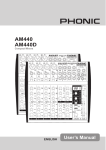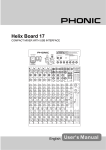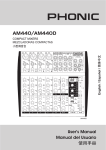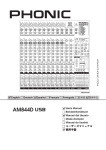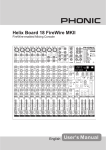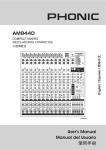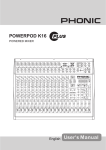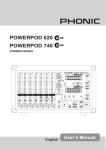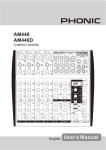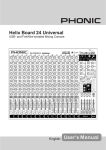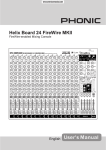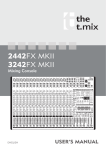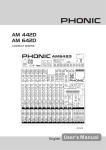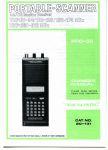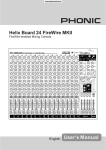Download Phonic AM844D manual
Transcript
AM844D Compact Mixer AM844D ENGLISH User’s Manual IMPORTANT SAFETY INSTRUCTIONS The apparatus shall not be exposed to dripping or splashing and that no objects filled with liquids, such as vases, shall be placed on the apparatus. The MAINS plug is used as the disconnect device, the disconnect device shall remain readily operable. Warning: the user shall not place this apparatus in the confined area during the operation so that the mains switch can be easily accessible. 1. Read these instructions before operating this apparatus. 2. Keep these instructions for future reference. 3. Heed all warnings to ensure safe operation. 4. Follow all instructions provided in this document. 5. Do not use this apparatus near water or in locations where condensation may occur. 6. Clean only with dry cloth. Do not use aerosol or liquid cleaners. Unplug this apparatus before cleaning. 7. Do not block any of the ventilation openings. Install in accordance with the manufacturer’s instructions. 8. Do not install near any heat sources such as radiators, heat registers, stoves, or other apparatus (including amplifiers) that produce heat. 9. Do not defeat the safety purpose of the polarized or grounding-type plug. A polarized plug has two blades with one wider than the other. A grounding type plug has two blades and a third grounding prong. The wide blade or the third prong is provided for your safety. If the provided plug does not fit into your outlet, consult an electrician for replacement of the obsolete outlet. 10. Protect the power cord from being walked on or pinched particularly at plug, convenience receptacles, and the point where they exit from the apparatus. CAUTION RISK OF ELECTRIC SHOCK DO NOT OPEN CAUTION: TO REDUCE THE RISK OF ELECTRIC SHOCK, DO NOT REMOVE COVER (OR BACK) NO USER SERVICEABLE PARTS INSIDE REFER SERVICING TO QUALIFIED PERSONNEL The lightning flash with arrowhead symbol, within an equilateral triangle, is intended to alert the user to the presence of uninsulated “dangerous voltage” within the product’s enclosure that may be of sufficient magnitude to constitute a risk of electric shock to persons. The exclamation point within an equilateral triangle is intended to alert the user to the presence of important operating and maintenance (servicing) instructions in the literature accompanying the appliance. WARNING: To reduce the risk of fire or electric shock, do not expose this apparatus to rain or moisture. CAUTION: Use of controls or adjustments or performance of procedures other than those specified may result in hazardous radiation exposure. 11. Only use attachments/accessories specified by the manufacturer. 12. Use only with a cart, stand, tripod, bracket, or table specified by the manufacturer, or sold with the apparatus. When a cart is used, use caution when moving the cart/apparatus combination to avoid injury from tipover. 13. Unplug this apparatus during lighting storms or when unused for long periods of time. 14. Refer all servicing to qualified service personnel. Servicing is required when the apparatus has been damaged in any way, such as power-supply cord or plug is damaged, liquid has been spilled or objects have fallen into the apparatus, the apparatus has been exposed to rain or moisture, does not operate normally, or has been dropped. AM844D AM844D Compact Mixer CONTENTS INTRODUCTION......................................................................................................................... 4 FEATURES.................................................................................................................................. 4 GETTING STARTED................................................................................................................... 5 CHANNEL SETUP.......................................................................................................................5 MAKING CONNECTIONS............................................................................................................6 CONTROLS AND SETTINGS......................................................................................................9 DIGITAL EFFECT ENGINE....................................................................................................... 12 MASTER SECTION.................................................................................................................. 13 APPLICATION........................................................................................................................... 16 DIMENSIONS............................................................................................................................ 17 DIGITAL EFFECT TABLE.......................................................................................................... 18 SPECIFICATIONS..................................................................................................................... 19 BLOCK DIAGRAMS.................................................................................................................. 21 Phonic reserves the right to improve or alter any information suppied within this document without prior notice. V1.1 MAY 8, 2006 AM844D INTRODUCTION FEATURES Thank you for choosing one of Phonic’s many quality compact mixers. The brand new AM844D Mixers – designed by the ingenious engineers that have created a variety of mixers fantastic in style and performance in the past – display similar proficiency that previous Phonic products have shown; with more than a few refinements, of course. Featuring full gain ranges, amazingly low distortion levels, and incredibly wide dynamic ranges, these amazing mixers are bound to make a big splash in the World of mixing. We know how eager you are to get started – wanting to get the mixer out and hook it all up is probably your number one priority right now – but before you do, we strongly urge you to take a look through this manual. Inside, you will find important facts and figures on the set up, use and applications of your brand new mixer. If you do happen to be one of the many people who flatly refuse to read user manuals, then we just urge you to at least glance at the Instant Setup section. After glancing at or reading through the manual (we applaud you if you do read the entire manual), please store it in a place that is easy for you to find, because chances are there’s something you missed the first time around. ● ● ● ● ● ● ● ● ● ● ● ● Audiophile-Quality & ultra low noise 8 Mic/Line channels with inserts and phantom power 4 stereo channels with 4-band EQ 4 true subgroups with main L and R routing switches and double-bused outs 10 mic preamps with +48V phantom power Direct outputs for multi-track recording 3-band EQ with swept mid-range plus low cut on each mono channel 18dB/oct, 75Hz low cut filter on each mic channels 4 aux sends, aux 1 & 2 with Pre/Post switch 4 stereo aux returns, 2 with effect to monitor +4/-10 level matching on Ch9/10, Ch11/12 stereo line in for expanded applications. 32/40-bit digital stereo 100-effect processor with tap control plus test tone generator and foot switch on/off control ● Control Room and Phones outputs with multi input sources select function ● Built-in switching power supply with universal connector, 100-240VAC, 50/60Hz ● Rack-mounting kit included AM844D GETTING STARTED CHANNEL SETUP 1. Ensure all power is turned off on the AM844D Mixer. To totally ensure this, the AC cable should not be connected to the unit. 2. All faders and level controls should be set at the lowest level and all channels switched off to ensure no sound is inadvertently sent through the outputs when the device is switched on. All levels should be altered to acceptable degrees after the device is turned on. 3. Plug all necessary instruments and equipment into the device’s various inputs as required. This may include line signal devices, as well as microphones and/or guitars, keyboards, etc. 4. Plug any necessary equipment into the device’s various outputs. This could include Amplifiers, active speakers or monitors, signal processors, and/or recording devices. 5. Plug the supplied AC cable into the AC inlet on the back of the device ensuring the local voltage level is identical to that required on your device. 6. Plug the supplied AC cable into a power outlet of a suitable voltage. 7. Turn the power switch on. 1. To ensure the correct audio levels of each input channel is selected, every channel should first be switched off and all faders set to 0. 2. Choose the channel that you wish to set the level of, and ensure that channel has a signal sent to it similar to the signal that will be sent when in common use. For example, if the channel is using a microphone, then you should speak or sing at the same level the performer normally would during a performance. If a guitar is plugged into that channel, then the guitar should also be used as it normally would be. 3. Press the Solo button of the channel, and engage the “level set” button next to the level meter, allowing you to see the PFL audio signal level in the level meter. 4. Set the gain of the selected channel to a level that ensures the audio level is around 0 dB, as indicated by the level meter. 5. This channel is now ready to be used; you can stop making the audio signal. 6. To activate the channel, release the Solo button and engage the channel’s on button and press the 1/2, 3/4 or L/R routing buttons, allowing the signal to be sent to the corresponding destinations. 7. You should now select the next channel to set and go back to follow steps 1 through 6. AM844D MAKING CONNECTIONS Channel Inputs 1. XLR Jacks These jacks accept XLR inputs for balanced signals. They can be used in conjunction with microphones such as professional condenser, dynamic or ribbon microphones - with standard XLR male connectors. With low noise preamplifiers, these inputs serve for crystal clear sound replication. NB. When using an unbalanced microphone, please ensure phantom power is switched off. However, when using condenser microphones the phantom power should be activated. 2. Line In Jacks These inputs accept 1/4” TRS and 1/4” TS line inputs for the addition of various music instruments – such as keyboards, drum machines, electric guitars, as well as a variety of other electric instruments. 3. INS (External Device Insert Jack) The primary use for these TRS phone jacks is for the addition of external devices, such as dynamic processors or equalizers, to the corresponding mono input channel. This will require a Y cord that can send and receive signals of the mixer to and from an external processor. 4. Stereo Channel Inputs The AM 844D features 4 stereo input channels (channels 9 through to 16), the inputs of which differ slightly to the mono channels. The 3-pin XLR inputs on the first two stereo inputs are for the addition of microphones with typical XLR male inputs, where the Line 1/4” TRS jacks are for the addition of various stereo line level input devices, such as keyboards. If you wish to use a monaural device on a stereo return input, simply plug the device’s 1/4” phone jack into the left (mono) stereo input and leave the right input bare. The signal will be duplicated to the right due to the miracle of jack normalizing. 4 4 MASTER SECTION 5. 2T Return These inputs accommodate RCA connectors from such devices as tape and CD players, PCs and other sources. The level of this input can just adjusted using the 2T Return control on the face of the Mixer. 6. Record Outputs As with the 2T Inputs, these outputs will accommodate RCA connectors, able to be fed to a variety of recording devices. 5 6 AM844D 7. Phones Outputs These output ports are suited for use with headphones or headphone amplifiers, allowing monitoring of the mix. The audio level of this output is controlled using the Control Room / Phones control on the front panel’s master section. 8. 12V Lamp This BNC socket allows you to attach a 12 Volt gooseneck lamp, allowing better visibility in areas with poor light. 10. Auxiliary (AUX) Sends These 1/4” phone jacks are the final output of linelevel signal fed from the corresponding auxiliary send mixing buses, and are best suited for use with stage monitors. Feeding the output from the Auxiliary outs to an amplifier - and possibly an equalizer - and then to a floor monitor speaker allows artists to monitor their own instruments or vocals whilst performing. There are four AUX Sends at the AM 844D. 0 8 7 REAR PANEL 9. Direct Outs These connections are for the direct output of the signals received by mono channels 1 through to 8, post-fader, post-EQ, post-HPF, post-mute. They are most commonly used to connect Multi-track recorders and they can be also used to connect your multichannel audio to your DAW, AM 844D can also be used as an 8-track studio mixer. 9 AM844D 11 Main Outputs These outputs will output the final stereo line level signal sent from the main mixing bus. The primary purpose of the two XLR jacks is to send the main output to external devices, which may include power amplifiers (and in-turn, a pair of speakers), other mixers, as well as a wide range of other possible signal processors (equalizers, crossovers, etcetera). The two 1/4” phone jacks are able to send the Main output to external devices that may run in parallel with the mixer. This may include additional power amplifiers, mixers, PA systems, as well as a wide range of other possible signal processors. 12. Main Insert Located on the rear of the AM 844D, the primary use for these TRS phone jacks is for the addition of external devices, such as dynamic processors or equalizers, to the main L and main R signals. This will require a Y cord that can send (pre-fader) and receive signals to and from an external processor. 13. CTRL RM Control Room Outputs These two 1/4” Phone Jack outputs feed the signal altered by the Control Room level control on the face of the mixer. This output has extensive use, as it can be used to feed the signal from the mixer to an active monitor, for the monitoring of the audio signal from within a booth, among many other possible uses. 14. Foot Switch Jack The foot switch port is for the inclusion of a foot switch, used for remote activation and deactivation of the built-in Digital Effect processor. NB. When any device is plugged into the mixer’s corresponding EFX Return inputs (AUX Return 3), the mixer’s internal digital effect engine is then disabled. 5 6 4 15. Group Outs These 1/4” phone jacks output the final feed from the Group 1/5, 2/6, 3/7 and 4/8 Faders on the main panel of the mixer. These outputs can be sent to the Left or Right Main channels using the corresponding selector, they can also be used to feed multi-track records, as well as an amplifier and speakers to be used along with the Main Speakers. Since the signal of Group 1 is mimicked to the Group 5 output, Group 2 to Group 6 – and so forth – these outputs can easily be used to feed an 8 track recorder by simply connecting the Group outputs to the corresponding Multi-track input channels. Similar to if a Y-cord was built into your AM 844D! 16. AUX Returns The 1/4” TRS AUX Return inputs are for the return of audio to the AM 844D mixers, processed by an external signal processor. If really needed, they can also be used as additional inputs. The feed from these inputs can be adjusted using the AUX Return controls on the face of the mixer. When connecting a monaural device to the AUX Return 1, 2 and 4 inputs, simply plug a 1/4” phone jack into the left (mono) input, and the signal will appear in the right as well. You can use balanced and unbalanced signals. 17. Power Connector and Fuse Holder Used for the addition of a power cable and supply, allowing power to be supplied to the mixer. Please use the power cable that is included with this mixer only. The Fuse holder, located above the AC Power connector, is, of course, for the AM 884D’s fuse. If the fuse happens to blow, open the holder cover, and replace the fuse with a suitable replacement (as indicated on the fuse holder’s cover). 7 AM844D CONTROLS AND SETTINGS Rear Panel 18. Power Switch You can use it to turn the mixer on and off. Ensure you turn all level controls down before activating. 8 9 19. Phantom Power Switch When this switch is in the on position, it activates +48V of phantom power for all microphone inputs, allowing condenser microphones (well, the ones that don’t use batteries) to be used on these channels. Activating Phantom Power will be accompanied by an illuminated LED above the left channel Level Meter. Before turning Phantom Power on, turn all level controls to a minimum to avoid the possibility of a ghastly popping sound from the speakers. NB. Phantom Power should be used in conjunction with balanced microphones. When Phantom Power is engaged, single ended (unbalanced) microphones and instruments should not be used on the Mic inputs. Phantom Power will not cause damage to most dynamic microphones, however if unsure, the microphone’s user manual should be consulted. 0 Channel Controls 20. Line/Mic Gain Control This controls the sensitivity of the input signal of the Line/Microphone input of mono channels, the gain should be adjusted to a level that allows the maximum use of the audio, while still maintaining the quality of the feed. This can be accomplished by adjusting it to a level that will allow the peak indicator occasionally illuminate. On channels 9-10 and 11-12, the gain control affects the microphone input only, and on channels 13-14 and 15-16, this only affects line inputs (as there are no microphone inputs on these channels). 21. Low Cult Filter (75 Hz) Located on channels 1 through to 8, will activate a high-pass filter that reduces all frequencies below 75 Hz at 18 dB per Octave, helping to remove any unwanted ground noise or stage rumble. Stereo channels does not feature this low cut filter. 22. +4/-10dB Buttons Located on stereo channels 9-10 and 11-12, these buttons select the input signal level, allowing the mixer to better adapt to different operating levels. If the input source is -10 dBu (consumer audio standard), it is best to engage the switch, allowing the signal to be heard. If the input source is +4 dbV (professional audio standard) the corresponding input channel’s button should be disengaged to ensure the integrity of the Mixer’s circuitry. If you are unsure of the source’s operating level, we suggest leaving the switch disengaged until you test the source’s signal. You can then engage if necessary (if the level of input is obviously too low). AM844D 23. High Frequency Control Use it to give a shelving boost or cut of ±15 dB to high frequency (12 kHz) sounds. This will adjust the amount of treble included in the audio of the channel, adding strength and crispness to sounds such as guitars, cymbals, and synthesizers. 24. Middle Frequency Control You can provide a peaking style of boost and cut to the level of middle frequency sounds at a range of ±15 dB with this control. The AM 844D mixer also provides a sweep control, allowing you to select a center frequency between 100 Hz and 8 kHz. Changing middle frequencies of an audio feed can be rather difficult when used in a professional audio mix, as it is usually more desirable to cut middle frequency sounds rather than boost them, soothing overly harsh vocal and instrument sounds in the audio. The stereo channels of the AM 844D mixer feature a High-Mid and Low-Mid control instead of the typical controls described above. They provide a peaking style of boost and cut to middle frequencies, where the frequencies are set at 3 kHz and 800 Hz for the High- and Low-Mids respectively. 25. Low Frequency Control This control is used to give a shelving boost or cut of ±15 dB to low frequency (80 Hz) sounds. This will adjust the amount of bass included in the audio of the channel, and bring more warmth and punch to drums and bass guitars. 26. AUX Controls These four AUX controls alters the signal level that is being sent to the auxiliary 1 to 4 mixing buses, the signal of which is suitable for connecting stage monitors, allowing artists to listen to the music that is being played. AUX 1 and 2 feature a Pre/Post button, which alternates the feed to the AUX mixing bus between a post and pre-fader feed. AUX 3, on the other hand, acts as an EFX send, the signal of which can be used in conjunction with external signal processors (which can be returned to the mixer via the AUX return input), or simply as an Auxiliary output. Both the AUX 3 (EFX) and AUX 4 controls are post fader and are sent directly to the corresponding outputs. 27. Pan / Balance Controls This alternates the degree or level of audio that the left and right side of the main mix should receive. On mono channels, the PAN control will adjust the level that the left and right should receive (pan), where as on a stereo channel, adjusting the BAL control will attenuate the left or right audio signals accordingly (balance). 6 7 4 5 10 AM844D 28. On Button and Indicator This turns the channel on, allowing the user to use the feed from the channel’s inputs to supply the MAIN L/R, GROUP 1/2, GROUP 3/4, AUX and EFX buses (as specified by the user, of course). The corresponding indicator will be illuminated when turned on. 29. 1-2, 3-4 and L-R Buttons These handy buttons allow you to decide the audio path of the corresponding channel. Pushing the “1/2” or “3/4” buttons allows the signal to be sent to the Group 1/2 or 3/4 mixes respectively, where the “L-R” allows it to be sent to the Main L/R mix. 30. Peak Indicator This LED indicator will illuminate when the channel hits high peaks, 6 dB before overload occurs. It is best to adjust the channel level control so as to allow the PEAK indicator to light up on regular intervals only. This will ensure a greater dynamic range of audio. This indicator also doubles as a Solo indicator, when the SOLO button is engaged. 31. Solo Button The Solo button is pushed to allow the signal of the corresponding channel to be sent to the Control Room / Phones mixing bus (pre or post fader, depending on the properties selected by the pre / post button, located by the Control Room / Phones source buttons), for use with either headphones or studio monitors. This button also allows for easier isolation of individual channel signals, ensuring setting of the input gain or tracking of audio by sound engineers is made simpler. The Peak indicator above the Solo button also doubles as a Peak Indicator, illuminating when the signal reaches high peaks. 32. Channel Level Control (Fader) This control will alter the signal level that is sent from the corresponding channel to the corresponding mixing buses. 8 9 0 AM844D 11 Digital Effect Engine 33. Digital Effect Display This 2-digital numeric display shows the program number that is currently applied to your EFX audio signal. When you rotate the Program control, you can scroll through different program numbers; however the display will revert back to the original program if a new program is not selected within a few seconds. For a list of available effects, please observe the Digital Effect Table. 34. Sig and Clip Indicators Located within the Digital Effect Display are Clip and Sig LEDs. The Sig LED will light up when any signal is received by the effect processor, and the Clip LED will light up shortly before excessive signals are dynamically clipped. If the Clip LED lights up too often, it may be advisable to turn down one or all EFX controls on input channels to ensure the signal level is not too high. 4 35. Program Control This control is used to scroll through the various effects. Turning the control clockwise will allow users to ascend into higher program numbers, and turning it counter-clockwise will allow users to descend into lower program numbers. Pushing this control will apply the new effect. When a tap-delay effect is selected, pressing this control will allow users to select the tap-delay time. By pushing the button several times, the effect processor interprets the time between last two pushes and remembers this as the delay time, until the button is pushed again (this is kept, even after the power is turned off). When the tap delay effect is selected, a small LED will flash within the digital effect display window at the selected intervals. 36. Effect On Button This button is pushed to turn the internal effect processor on or off. 5 6 12 AM844D Master Section 37. AUX Return 1 and 2 Controls These controls adjust the signal level of audio fed through to the stereo AUX Return inputs. The “To AUX Send 1” and “To AUX Send 2” controls adjust the pre-fader level of the signal from the AUX Return controls to the corresponding AUX mixing buses for effect-to-monitor sends. 38. EFX Return Control This control adjusts the signal level of audio fed through to stereo AUX Return 3 inputs. If no device is plugged into the AUX Return 3 inputs, it then acts as the final level control of the built-in Digital Effect Engine. 39. Main L/R - Group Buttons The first of these buttons changes the destination of the signal sent from the AUX Return 3 mixing buses between the Main L/R and Group mixing buses. The second button works when the user selects to send the signal “To Group”, allowing the signal to be sent to either Group 1-2 or Group 3-4. 7 7 40. AUX Return 4 Control This control adjusts the signal level of audio fed through to the stereo AUX Return 4 inputs. The accompanying “C-R Phones Only” button allows users to send the signal to the Control Room / Phones mixing bus for monitoring purposes. 41. Solo Returns Button Pushing this buttons allows you to send the signal from all AUX Returns to solo mixing bus (which is, intern, send to the Control Room / Phones mixing bus). When the Solo is activated, the corresponding LED indicator will illuminate. 42. AUX Send Master Controls These controls adjust the final level of the AUX 1, 2 and 3/4 signals (as taken from the AUX 1, 2, 3 and 4 level controls on each channel strip), the audio of which is sent to the corresponding AUX send outputs. The SOLO buttons accompanying these controls allow you to send the AUX send signals to the Control Room / Phones mixing bus for monitoring purposes. 43. AUX Solo Buttons Pushing one or more of these buttons allows you to send the signals from the AUX 1, 2 or 3/4 mixing buses to the Control Room / Phones mixing bus. 8 9 4 4 4 40 AM844D 13 44. Solo Mode Button and Indicator This button alternates the solo source signals between those of post-fader (normal) and pre-fader feeds (level set), to be sent to the Control Room / Phones mixing bus. When the Solo indicator, located beside the Level Meter, is illuminated, one or more Solo buttons has been pushed; therefore the Level meter will display properties of the Solo signal, which is helpful with setting of channel properties. If the Solo indicator illuminates green, this means the Solo feed is a pre-fader signal. If the solo indicator illuminates red, the feed is post-fader. If no Solo buttons are activated, the Control Room / Phones selected sources (Main L-R, Group 1-2, Group 3-4 and/or 2T Return) signal properties are displayed by the Level Meter. In this case, the Level meter will display the sum of the selected signals. 46 45 47 44 45. 2T Return Controls Turning the 2T Return level control adjusts the signal level of the feed from the 2T Return inputs. The “to Main L/R” button that accompanies this control allows users to send the 2T return signal to the Main L-R mixing bus. When this is done, the 2T return signal is not sent to the Rec Out, as to avoid producing a feedback loop when recorded signals are fed back into the 2T return. 46. Control Room / Phones Control This control is used to adjust the audio level of the Control Room and Phones feeds, for use in the monitoring and tracking of audio. The signal of the control Room / Phones mixing bus is decided by the Source Selection buttons located immediately below this control. If no buttons are selected, the solo signal will be used instead. 47. Control Room / Phones Source Selection These four buttons allow users to select the various possible sources for the Control Room and Phones outputs. By simply pushing one of these buttons, users have the ability to monitor the Group 1-2, Group 3-4, Main L-R and 2T return signals, either together or individually. Priority High Low Signal From Solo Selected Source(s) 48. +48V Indicator The internal Phantom Power will be activated when you turn on this switch. 49. Power Indicator The Power Indicator will light up when the power of the mixer is on; in case you weren’t too sure. 48 14 49 AM844D 50. Level Meter The dual 12 segment level meter gives an accurate indication of when audio levels of the Main L/R signal reach certain levels. The 0 dB indicator illuminates is approximately equal to an output level of +4 dBu (balanced), and the PEAK indicator illuminates about 1.5 dB before the signal is dynamically clipped. To make the maximum use of audio, set the various level controls so that it sits steadily around 0 dB to make full use of audio, while still maintaining fantastic clarity. 50 51. Group 1/5, 2/6, 3/7 and 4/8 Controls These four faders are the final level control for the Group 1 to 4 audio feeds (the signals of which are doubled in the 5 – 8 Group outputs), sent to the corresponding Group outputs on the rear of the AM844D to feed external devices such as effect processors, and, most commonly, multi-track recorders. These faders can be fed a signal from the various mono and stereo channels, as well as the AUX Return 3, depending on your selections. When pushed all the way up, these faders provide 10 dB of gain to the signal, and, when set all the way down, effectively mute the signal. AM844D The Group Controls also feature individual left and right buttons, which allow you to send the various Group signals to the Main Left and Right. This can be handy when wanting to combine the signals from different signals and control their input levels simultaneously, then send them to the Main L/R signal (eg. when multiple inputs are used for, say, drums, you can combine these inputs together to be controlled much simpler by a single fader). 52. Main L/R Fader The Left and Right main mix is controlled with this fader – the final level control for the Main Left and Right audio feeds, sent to the Main L and R outputs. When pushed all the way up, the Main L/R fader provides 10 dB of gain to the signal, and when set all the way down, the signal is effectively muted. 5 5 15 APPLICATION There are potentially hundreds of ways to connect instruments and devices to the AM Mixers. It is advisable that you explore the functions and find the best setup possible for your needs, which may depend on what instruments you wish to connect, as well as how many external devices you wish to connect and your required monitoring applications. Combining the use of different instruments with the mixer’s special functions (such as digital effect processing, in the case of the AM440D) will ensure that your audio sounds exactly the way you want it. 16 AM844D DIMENSIONS * All measurements are shown in mm/inches. AM844D 17 DIGITAL EFFECT TABLE NO PARAMETER SETTING REV-TIME EARLY LEVEL 00 COMPACT ROOM 1 0.05 100 01 COMPACT ROOM 2 0.4 02 SMALL ROOM 1 03 SMALL ROOM 2 04 05 NO PROGRAM NAME PARAMETER SETTING PAN SPEED 56 SLOW PAN 0.1 R-->L 0 57 SLOW PAN 1 0.1 R<-->L 0.45 100 58 SLOW PAN 2 0.4 R-->L 0.6 90 59 MID SHIFT 0.8 R<-->L MID ROOM 1 0.9 100 60 MID SHIFT 1 1.2 L-->R MID ROOM 2 1 50 61 MID SHIFT 2 1.8 L-->R 06 BIG ROOM 1 1.2 100 62 MID SHIFT 3 1.8 R-->L 07 TUNNEL 3.85 100 63 FAST MOVE 3.4 R<-->L HALL REV-TIME EARLY LEVEL TREMOLO SPEED MODE-TYPE 0.9 90 64 LAZY TREMOLO 0.8 TRG 08 JAZZ CLUB TYPE 09 SMALL HALL 1 1.5 72 65 VINTAGE TREMOLO 1.5 TRG 10 SMALL HALL 2 1.75 85 66 WARM TREMOLO 2.8 TRG 11 SPRING HALL 1.9 98 67 WARM TREMOLO 1 4.6 TRG 12 MID HALL 1 2.3 100 68 HOT TREMOLO 6.8 TRG 13 MID HALL 2 2.45 80 69 HOT TREMOLO 1 9.6 TRG 14 RECITAL HALL 2.7 96 70 CRAZY TREMOLO 1 15 TRG 15 BIG HALL 2 3.3 88 71 CRAZY TREMOLO 2 20 PLATE REV-TIME HPF DELAY+REV REV DELAY-1 16 SMALL PLATE 0.9 0 72 DELAY+REV 1 1 1 17 TAIL PLATE 1.2 20 73 DELAY+REV 2 2 2 18 MID PLATE 1 1.3 0 74 DELAY+REV 3 3 3 19 MID PLATE 2 2.2 0 75 DELAY+REV 4 4 4 20 REVERSE PLATE 2.25 42 76 DELAY+REV 5 5 5 21 LONG PLATE 1 2.6 80 77 DELAY+REV 6 6 6 22 LONG PLATE 2 3 625 78 DELAY+REV 7 7 7 23 LONG PLATE 3 4.2 0 79 DELAY+REV 8 8 8 DELAY-1(stereo) DELAY AVERG. R-LEVEL CHORUS+REV REV CHORUS 24 SHORT DELAY 1 0.07 60 80 CHORUS+REV 1 1 1 25 SHORT DELAY 2 0.14 60 81 CHORUS+REV 2 2 2 26 PING PONG DELAY 0.11 55 82 CHORUS+REV 3 3 3 27 MID DELAY 1 0.15 55 83 CHORUS+REV 4 4 4 28 MID DELAY 1 0.3 60 84 CHORUS+REV 5 5 5 29 SHORT DELAY 1 (MONO) 0.06 100 85 CHORUS+REV 6 6 6 30 MID DELAY 1 (MONO) 0.13 100 86 CHORUS+REV 7 7 7 31 LONG DELAY 1 (MONO) 0.18 100 87 CHORUS+REV 8 8 CHORUS LFO DEPTH FLANGER+REV REV 32 SOFT CHORUS 0.2 56 88 FLANGER+REV 1 1 1 33 SOFT CHORUS 2 0.5 70 89 FLANGER+REV 2 2 2 34 SOFT CHORUS 3 0.8 75 90 FLANGER+REV 3 3 3 35 WARM CHORUS 1.8 85 91 FLANGER+REV 4 4 4 36 WARMER CHORUS 1 3.2 80 92 FLANGER+REV 5 5 5 37 WARMER CHORUS 2 5.2 45 93 FLANGER+REV 6 6 6 38 WARMER CHORUS 3 7.8 52 94 FLANGER+REV 7 7 7 39 HEAVY CHORUS 9.6 48 95 FLANGER+REV 8 8 8 FLANGER LFO DEPTH GATED-REV RELEASE REV 40 CLASSIC FLANGER 1 0.1 44 96 GATED-REV-1 9 0.02 TAIL PLATE 41 CLASSIC FLANGER 2 0.3 63 97 GATED-REV-2 10 0.2 TAIL PLATE 42 GENTLE FLANGER 0.6 45 98 GATED-REV-1 9 0.02 REVERSE PLATE WARM FLANGER GATED-REV-2 10 0.5 REVERSE PLATE 43 TRG 8 FLANGER 1.6 60 99 44 MODERN FALANGER 1 2 85 TAP DELAY FB LEVEL RANGE 45 MODERN FALANGER 2 2.8 80 A0 TAP DELAY 0 100mS - 2.7S 46 DEEP FALANGER 1 4.6 75 A1 TAP DELAY 10 100mS - 2.7S 47 DEEP FALANGER 2 10 60 A2 TAP DELAY 20 100mS - 2.7S PHASER LFO DELAY A3 TAP DELAY 30 100mS - 2.7S 18 PROGRAM NAME ROOM 48 CLASSIC PHASER 1 0.1 3.6 A4 TAP DELAY 40 100mS - 2.7S 49 CLASSIC PHASER 2 0.4 2.6 A5 TAP DELAY 50 100mS - 2.7S 50 COOL PHASER 1.4 0.7 A6 TAP DELAY 60 100mS - 2.7S 51 WARM PHASER 3.2 0.3 A7 TAP DELAY 70 100mS - 2.7S 52 HEAVY PHASER 1 5 1.2 A8 TAP DELAY 80 100mS - 2.7S 53 HEAVY PHASER 2 6 2.8 TEST TONE FREQUENCY SHAPE 54 WILD PHASER 1 7.4 0.8 T0 LOW FREQUENCY 100Hz SINEWAVE 55 WILD PHASER 2 9.6 4.8 T1 MID FREQUENCY 1kHz SINEWAVE T2 HIGH FREQUENCY 10kHz SINEWAVE PN PINK NOISE 20Hz~20kHz AM844D SPECIFICATIONS Model Name AM 844D Inputs Total Channels 12 Balanced Mono Mic / Line channel 8 Balanced Mic / Stereo Line channel2 Balanced Stereo Line Channel2 Aux Return 2T Input 4 stereo Stereo RCA Outputs Main L/R Stereo2 x 1/4” TRS, Bal. & 2 x XLR Main out with inserts Rec Out Yes Stereo RCA CTRL RM L/R2 x 1/4” TS Phones2 Direct Out Channel Strips Aux Sends Pan/Balance Control Mic/Line Ch1~ Ch8 12 4 Yes Channel Insert Ch 1 ~ Ch 8 Volume Controls 60mm fader Master Section Aux Send Masters 3 Master Aux Send Solo 3 Stereo Aux Returns 4 Aux Return Assign to Subgroup 1 Effects Return to Monitor 2 Global AFL/PFL Solo Mode Faders Yes 4 subgroups, Main L & R Metering Number of Channels2 Segments12 Phantom Power Supply Switches 32/40-bit Digital Effect Processor +48V DC Master 100 effects with tap delay control, Test tone and foot switch (effect on/off) Frequency Response (Mic input to any output) 20Hz ~ 60KHz +0/-1 dB 20Hz ~ 100KHz +0/-3 dB Crosstalk (1KHz @ 0dBu, 20Hz to 20KHz bandwidth, channel in to main L/R outputs) Channel fader down, other channels at unity AM844D <-90 dB 19 Model Name AM 844D Noise (20Hz~20KHz; measured at main output, Channels 1-4 unit gain; EQ flat; all channels on main mix; channels 1/3 as far left as possible, channels 2/4 as far right as possible. Reference=+6dBu) Master @ unity, channel fader down -86.5 dBu Master @ unity, channel fader @ unity -84 dBu S/N ratio, ref to +4 >90 dB Microphone Preamp E.I.N. <-129.5 dBm (150 ohms terminated, max gain) THD (Any output, 1KHz @ +14dBu, <0.005% 20Hz to 20KHz, channel inputs) CMRR (1 KHz @ -60dBu, Gain at 80dB maximum) Maximum Level Mic Preamp Input +10dBu All Other Input +21dBu Balanced Output +28dBu Impedance Mic Preamp Input2 K ohms All Other Input (except insert)10 K ohms RCA 2T Output1.1 K ohms Ch Equalization Low EQ 3-band, +/-15dB (4-band on Stereo Ch) 80Hz Mid EQ (mono channel)100-8k Hz, sweepable LMid EQ (stereo channel) 800 Hz HMid EQ (stereo channel)3 kHz Hi EQ12 kHz Low cut filter Built-in Power Supply Net Weight Dimensions (WxHxD) 20 75 Hz (-18 dB/oct) 100-240 VAC, 50/60 Hz 5.9 kg (13 lbs) 418x140x438 mm (16.5”x5.5”x17.25”) AM844D AM844D BLOCK DIAGRAM AM844D 21 22 AM844D AM844D 23























